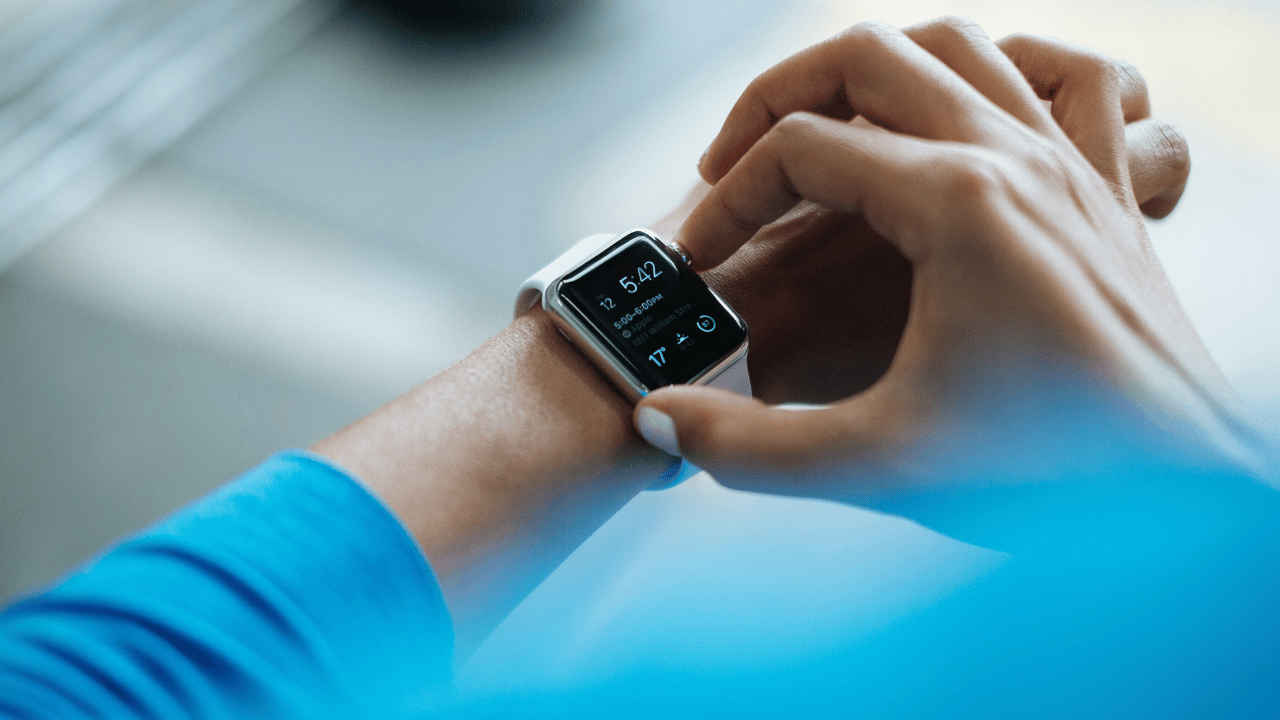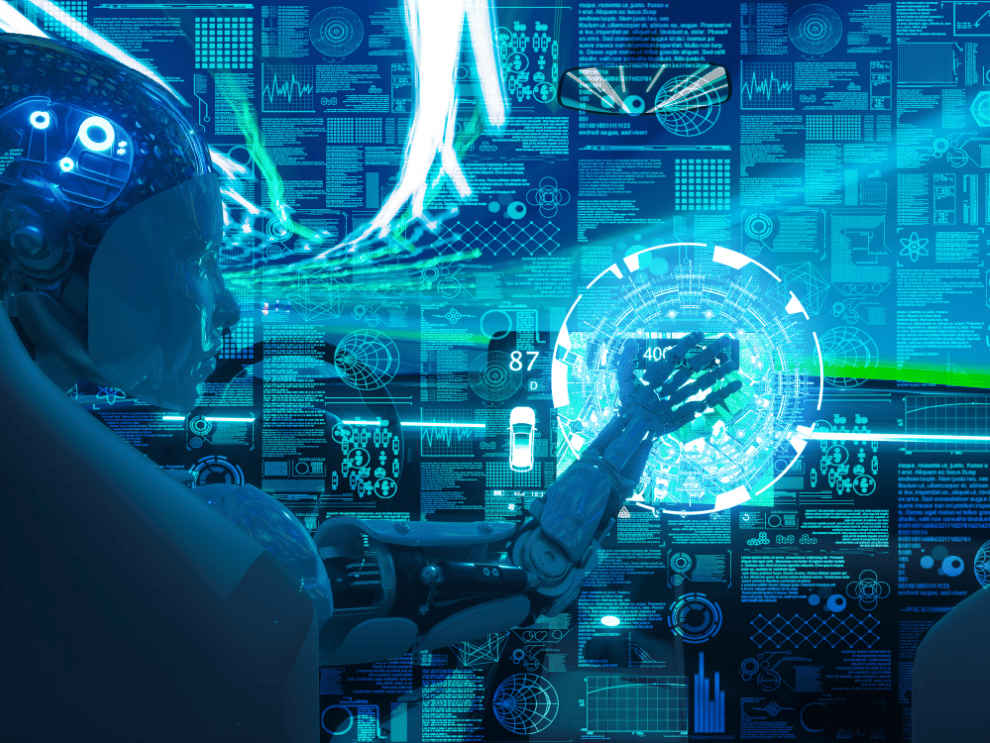Generating health using AI

If you run a chock-a-block schedule and really have no time to fix your fitness plans, you may cleverly mull over Chat GPT’s (Generative Pre-trained Transformer) assistance to do the job. In a world that is widely dominated by smart technology, such possibilities cannot be ruled out to make life easier and more organized. With the invasion of AI in every domain, gym wear and gear is also given a futuristic spin via virtual trainers and trackers. Working out now goes beyond being just a healthy routine and becomes an interesting pastime.
Penetration of AI in Workout Plans
With AI intervention, wearable technology is benefiting the fitness industry big time. “We have to align ourselves with the changing times, more so, when technology has steadily evolved to a 2.0 stage. So, it only makes sense to have recourse to AI at every level from ideation to deliveries,” views Urshila Rao Ganji, founder and creative head, OG & Co, a premium active wear line, fashioned out of sustainable materials.
Good news is that the fitness industry can build on its own transparency through immediate feedbacks and instant trials. “AI is a perfect pointer to determine the best clothing and fitting needs for different activities like swimming, running, etc. It also helps identify the most suitable outfits to scale up performances for attaining better results and this in itself is a huge game changer. People’s responses may not always show 100% accuracy,” she fathoms further.
Notably, the Ai-based wearables collect vital data as desired by the user, such as the duration of his exercise, calories he burnt, total kilometres he walked, his heart rate and many more, thereby helping individuals keep track of their fitness level. AI-aided applications enhance workout regimes and stabilize health. “The fitness apps make workouts more engaging and fun, thanks to real-time analytics and professional exercise suggestions provided to clients via AI. More sophisticated wearable technology in sports can monitor stride rate, ground contact time, stroke rate and force analysis, thus assisting athletes in perfecting their performances,” informs entrepreneur Diksha Gandhi of Brick by Brick fitness apparel brand, a name to reckon with in the athleisure category.
It’s true that artificial intelligence and machine learning models are impacting every sphere of our lives. Evidently, the fitness industry has also come under this purview over time, effectively employing today’s cutting-edge tools to help us take better care of ourselves. “When we fail to take the correct decisions or make the right choices on both professional and personal fronts, AI cuts in to simulate human-like capabilities to seamlessly sort out things and sift through the clutter,” shares Sanjay Kalirona, CEO and founder of Gizmore, a trendy and stylish smart accessories and audio brand in India.
Adding further, he reminds that “we all know how important it is to drink water but we invariably forget to have proper liquid intakes at regular intervals. So, the latest smartwatches track our hydration progress throughout the day with alerts set on the e-gadgets.”
The fitness industry sees a complete revolution with AI adoption, feel experts. “Yet, it won’t be unjust to say that the wearable space has just touched the tip of the iceberg and we can expect many more such use cases coming in the near future,” predicts Kalirona.
AI-powered wearables provide apt solutions for exercisers to raise their fitness bar with personalized coaching and feedback. “The Ai-led technology can analyze an individual's workout performance and accordingly offer real-time guidance and response. For example, a smartwatch with built-in sensors can track the heart rate, distance and pace to render customized support to the wearer, such as when to speed up or slow down,” explains Javed Khan, co-founder of Motion Fitness Pune that deals in fitness products.
Scoring high on the safety measure, AI-enabled wearables can monitor an individual's vital parameters and caution him in case of any unforeseen health emergencies. For example, a smartwatch with built-in heart rate sensors can warn the wearer if his heart beats too fast, indicating that the person needs to take a break and relax.
Another merit of wearable technology integrated with AI is its capacity to track the recovery process of an individual, such as sleep and stress levels to denote the optimal time for him to resume his workout. This can help prevent injury, ensuring that the concerned person is making the most of his gymming sessions.
Smart Equipment
Apart from smartwatches and trackers that measure medical parameters, there are other Ai-aided accessories that a person can wear on his body while working out. Considering that these devices track health parameters, Urshila debates that “in my opinion, even though the world is racing ahead, I would love to go back to the sand watch times! Having said that, sleep trackers are quite useful for those suffering sleep issues”.
According to Diksha, “smart belt, shoes and clothing emerge as suitable new-age tools to sweat it out at the gym for long hours to shape up and set fitness precedents.” Incidentally, wearable IoT devices also tapped into the apparel and fashion accessories industries. For instance, the introduction of the smart belt is an ideal example of smart clothing. The handy belt saves the user from fall risks. By using algorithms and embedded sensors, the smart belt can easily foretell the risk of fall from abnormal gait patterns. It measures symmetry and speed, and immediately signals the user if any potential fall risk is identified. The mobile phone application is also linked to the smart belt, which can visualise the potential weight gain by the user and can monitor his activity, for instance, sitting habits, calories and step count.
Ill-fitted shoes for players or individuals can cause unsteadiness and a balance problem to trigger immense pain. Smart shoes are implanted with IoT sensors and can easily overcome the aforementioned difficulty. The sensors keep track of the blood pressure and alter the shoe for comfort. Therefore, even if the feet get swollen by excessive physical activity, the player feels okay. The smart shoe also tracks calories, steps, posture, fatigue and other health factors to prevent damages. It is connected to the cellphone app via Bluetooth to provide prompt and tailor-made supervision.
Smart clothing fuses fashion with technology. Such type of clothes comes attached with many sensors to trace the physical condition of the wearer with accuracy. The same can detect temperature, respiration rate, heart rate and other health-related information, and can be used widely for military purposes too.
WHOOP in the United States is one of the best AI-aided accessories. The device can be worn beneath the inmost layers of clothing or inside socks to obtain personalised, in-depth perceptions about an individual’s health and fitness status. “Soon, there will be more such devices that can be conveniently worn round the clock to successfully track the health condition and notify any deviation from the prescribed fitness agenda,” forecasts Sanjay Kalirona. “Besides raising an alarm in times of a sudden exigency, these gizmos are fed with complex algorithms and AI to preempt any ailments that are likely to develop and allow us to take remedial actions consulting medical practitioners,” he volunteers.
AI Takes Charge of Health
Many gym instruments like treadmill, cycling, rings, bench press, dumbbells, kettlebells, skates etc. may undergo innovation to convey significant data when a person exercises. Equipment controlled by Ai is playing a pivotal role in converting the fitness grind into a hassle-free hi-tech realm. “Several workout machines are automated now. AI-based equipment have in-built voice detectors. Recently, the Shark Tank reality TV show featured a cool machine boasting of a specialised workout and personal trainer for every body type. A lot of ingenuity is on display now with the rising AI revolution, technically transforming the idea of fitness from its root,” observes Urshila.
Among a host of AI-controlled gym gears, smart bikes and mirrors are visibly grabbing attention. The smart bike is a top-of-the-line stationary instrument, offering exciting live and on-demand classes. It’s equipped with an adjustable HD touchscreen that swivels for easy viewing during off-bike workouts, such as yoga, barre or cross-training.
Mirror is one of the most design-minded of all the equipment. When not in use, it actually looks like a nice wall mirror but smoothly shifts into a screen during workouts. Mirror tracks the workouter’s metrics. As the heart rate is measured during various workouts, the score is based on staying within the stipulated heart-rate zones. While repeating a workout, how the latest performance stacks up against the previous figure is clearly seen.
A few other AI-powered gym equipment are smart treadmills, ellipticals, cycles, steppers et al, which not only track the on-time metrics but also impart virtual assistance.
“Practically, all equipment coalesced with IoT can be regulated by AI. The only exception at the moment is the weights, which AI cannot control,” reveals Kalirona.
AI: An Alarm Bell for Workout Emergencies
Many celebrities complained of cardiac issues while gymming and some even succumbed to that impact. For instance, actor Sidharth Shukla, comedian Raju Srivastav and even former Indian cricketer and BCCI President Sourav Ganguly suffered health problems while working out. So, one wonders if Ai can help alert trainers and people at the gym of upcoming health hazards so that precautionary measures can be taken to avoid untoward damages.
“Fitness in India became a part and parcel of our daily existence. Our food is great in terms of nutrition, and we are the founders of yoga, the best workout you can give yourself. Weightlifting and weight training are also fine as long as it is done under the right supervision,” agrees Urshila Rao. Coming to the moot issue, she elucidates: “We see celebrity trainers in particular, advising and prescribing medicines like doctors in a situation where their clients already had a history with certain workouts. However, trainers can rethink about this task and recommend expert advice or a second opinion for their clients. Nevertheless, treadmills and cycles, which show the pulse and the heart rate, have always been in brisk business to monitor the exerciser and pause when it's crossing the ideal rate.”
AI can definitely help reduce health risks beforehand, concedes Diksha Gandhi. “As AI devices track and record analytics of various metrics, it can help a person spot any irregularities in their heart rates, temperature, respiration rate and other health-related information through which appropriate preventive treatment can be meted out right away to address the upcoming health hazard,” she confirms.
As per gym operators, AI can be used to quickly evaluate the blood flow with precision. The researchers are also working on AI-assisted imaging techniques that can gauge the likelihood of a heart attack or any form of worst eventuality. The method can be applied by doctors and gym instructors to redress health perils and even suggest treatments and curative measures.
“At Gizmore, we are also working with our software partners to enable these features in our smartwatches. These are complicated algorithms and an extensive research is required to devise such a heads-up. We have all read of instances where an Apple smartwatch sent a timely warning and saved people’s lives but we still have a long way to go before pushing these widgets into the mainstream and get a solid approval from the medical councils,” opines Kalirona.
AI can be leveraged to develop farsighted models to study a person's vital signs, such as heart rate, blood pressure and oxygen levels, while they are exercising. The AI model can then utilise this data to recognise potential health menaces, such as heart attack, stroke or other cardiac issues.
“One way to implement this system is through wearable devices that track a person's vital parameters in actual time. These devices can be linked to an AI-driven monitoring system that analyzes the stats and sends alerts to trainers or the gym staff if there are any potential health threats. The system can also apprise the individual directly, encouraging him to take a break, drink water or even seek medical attention, if necessary,” comments Javed Khan.
AI models can assess a person's past workout files and design bespoke workout plans based on his fitness goals, preferences and health history. “Overall, AI-powered monitoring systems can be extremely beneficial to gym-goers and trainers alike but at the same time, it’s important to note that these systems are not intended to replace medical attention but rather provide early warning signs and support to lower the risk of serious health complications,” reminds Khan.
Pocket Pinch
Given the expansion of disruptive technology, one may ask about India's standpoint on the smart health industry. Is the country opening up to Ai-led fitness clothing and tools, and most importantly, what is its current market size? While many health exponents may express doubt about the sustainability aspect of AI-pivoted workout wear and its positive impact on the wearer as well as the environment, most admit in unison, that this could turn out to be a cost-intensive proposition both for gym owners and customers as investment surges by inducting this technology.
“It could be looked at as a calculative investment. Though with the advent of AI-regulated new technologies, the conventional gym equipment may tend to get obsolete, there’s definitely a capex involved that the gym owners would have to bear, directly making the membership charges dearer for the gym hoppers. So, for a short term, the introduction of AI in gyms appears expensive but if we consider the situation from a broader perspective, then in the long run, smart equipment will not only save money but also uplift people’s lives,” claims Dikhsha Gandhi.
In India, the AI-propelled health industry is roughly estimated to be a trillion dollar opportunity. The technology is already being incorporated into diagnostic algorithms for screening maladies ranging from cancer, diabetic retinopathy to cardiovascular disease. Healthcare applications of AI algorithms now include early illness detection, drug development trials, precise patient monitoring and self-care. Revenue in the digital fitness and well-being segment in India is projected to reach US $10.12 billion in 2023 and is expected to witness a CAGR of 21.59% during the 2023-2027 forecast period, anticipating a market volume of US $22.12 billion by 2027.
India is unambiguously warming up to AI-propelled gym wear. There is a growing awareness among people to get in the fitness mode, ever since the pandemic had peaked. “The market for fitness products has been exploding and demand for Ai-enabled gear is also assumed to spike soon,” updates Sanjay Kalirona.
From the financial angle, closer home, gym proprietors are concerned about their bottom lines and will only make fresh investments once they see a business scope for it. However, people are increasingly growing conscious about their health and wellness and such favorable developments act as a constant wake-up call for the physicians and medical professionals to help improve their patient's quality of life.
Going by a MarketsandMarkets report, AI in the global fitness market size is envisioned to grow from $223 million in 2020 to $1,362 million by 2025, seeing a CAGR of 43.3% in the forecast time frame. “This growth is being undeniably boosted by the rising awareness of fitness and the aggressive uptake of wearable devices entrenched with the most superior AI technology. Add to this, the soaring popularity of virtual fitness training and wellness reset programs,” assures Javed Khan.
Integrating AI-aided technology into gyms can induce exorbitant upfront costs for gym owners, such as purchasing and installing equipment, implementing software systems and recruiting the training staff. “However, the long-term benefits of this progressive technology can potentially outweigh these expenses by enriching the overall gym experience for customers, inflating member retention and bumping up the revenue base for gym owners,” Khan pinpoints the difference.
AI can help gym owners optimize their operations by automating certain tasks and furnishing data-driven material to help them make informed decisions about hiring personnel, equipment maintenance and member engagement. This can lead to higher efficiency and rein in costs for gym owners.
Of course, the specific costs and benefits of importing AI-aided technology for a gymming facility will depend on various factors, such as the dimension of the gymnasium, the kind of technology to be availed of and the fitness target set by the gym owner. “It's imperative for the gym helmers to carefully contemplate the outlays and gains before pumping funds into running the hub only to ensure that the same aligns with their business strategies,” concludes Khan.
Fit India Hit India
It is essential to remember that the Government of India's Fit India campaign was launched by Prime Minister Narendra Modi a couple of years back. Responding to her take on whether this initiative inspires a lot of people from all-age groups to be fitness freaks, Urshila Rao says: “I'm sure it does motivate people. Post COVID-19, there has been a substantial transition in the number of people enrolling in the fitness centres. There's been more awareness than ever as oil-free snacks also became a popular staple. Like I said, India is the hub of wellness since the ages of yore and the nation is only rediscovering and redefining the performance skills by returning to its roots.”
Manufacturing the company's fitness products/equipment and custom-built workout fabrics in-house, Rao affirms to subscribe to the Make in India initiative. “1000% we partake in the Make in India movement. I am a proud Indian, and our art and craftsmanship are topnotch but sadly very underrated. I only see big things for India in the future,” she chips in.
Incidentally, the FIT India drive was launched on August 29, 2019, with a view to make fitness a primary facet of our daily lives. “The mission of this movement was to bring about behavioural changes and move towards a more physically active lifestyle. There were different initiatives taken by many influential people after the big announcement. From schools to colleges to workplaces and even at old age homes, every group pitched in their bit to be a part of this project”, reminisces Diksha Gandhi.
Since its inception, the Make in India undertaking has given hope to several Indians. It not only inspired the industry players but also promoted many small-scale businesses and entrepreneurs. We are also buoyed by the same initiative. “95% of our clothing line-up is crafted domestically. From procuring, manufacturing, branding to everything else, all are done locally. We feel privileged to be the ambassadors of this atmanirbhar movement and showcase it on our website through our product menu,” states Gandhi.
Echoing similar sentiments, Sanjay Kalirona vouches for Gizmore’s complete alignment with the Union Government’s Make in India initiative. “Our entire range of smartwatches is now being manufactured in India. We recently announced our partnership with Optiemus Electronics Limited (OEL) to generate an output of one million smartwatches over the next 12 months. Our focus is to fetch in the key constituents to fuel production in India,” he reports. Additionally, the brand follows the Fit India movement and is consistently working into that direction.
For the uninitiated, the Fit India campaign promotes a slew of physical activities and sports among the citizens of India. It aims to encourage people to include disciplines like yoga, running, cycling, swimming and other sports activity in their daily routine for better health results. The initiative also unveiled several countrywide programs and events, such as the Fit India School Certification Program, Fit India Cyclothon, Fit India Freedom Run, among others to ramp up the fitness craze.
“The Fit India movement should pay off as physical activity is indispensable to good health and well-being. Regular exercise can decline the risk of obesity, diabetes, heart disease and stroke. It can also release mental stress. Overall, it is a fruitful initiative, intending to fortify the fitness report card of India and help build a healthier and more active nation,” comments Javed Khan. Moreover, he believes that the Make in India initiative has hitherto aided many MSMEs (Micro, Small & Medium Enterprises) to grow.
Intelligent Gym Wardrobe
Coming to smart wear, a set of gym-fit outfits can be monitored by Ai. Your mind may hover over track pants, sweat shirt, head/wrist band, sneakers and so on as many activewear brands directly supply smart products to office and residential gyms plus in schools for physical training classes and sports. “Wearable today comes in different shapes and sizes, and these sensors can be easily installed in any sportswear that touches our skin and can track the motion. In the West, sensors fitted to the underwear elastic and in sneakers are now commonplace,” says Kalirona. He goes on to include that his “company is currently working on a project to touch the lives of athletes and sportspersons in a meaningful manner”.
With IoT gripping our lives, activewear is not spared of its impact either. As a result, AI gets merged with shoes, outfits, gloves etc. Several brands already took the industry by storm and created an array of intelligent clothing with black compression shirts and pants, each containing five inertial sensors. These sensors generate crucial data for enhancing posture, technology, shape and the timing in sports. The clothing and wearable stripes incorporating sensors contribute to strength training and yoga.
Well-known fashion technology company Wearable X makes Nadi X (a line of activated yoga apparel) yoga pants including two kinds of sensor. “Wearable X is the future of wellness, amalgamating design, technology and a new fashion diktat to achieve a better quality of life,” inputs Diksha. The sensors are built-in speed metres and haptic monitors. Haptic monitoring creates vibrations by rotating a mass that reacts like a little gyroscope to motions. With respect to the earth's gravitational fields, the sensors measure positions on the X, Y and Z axes.








